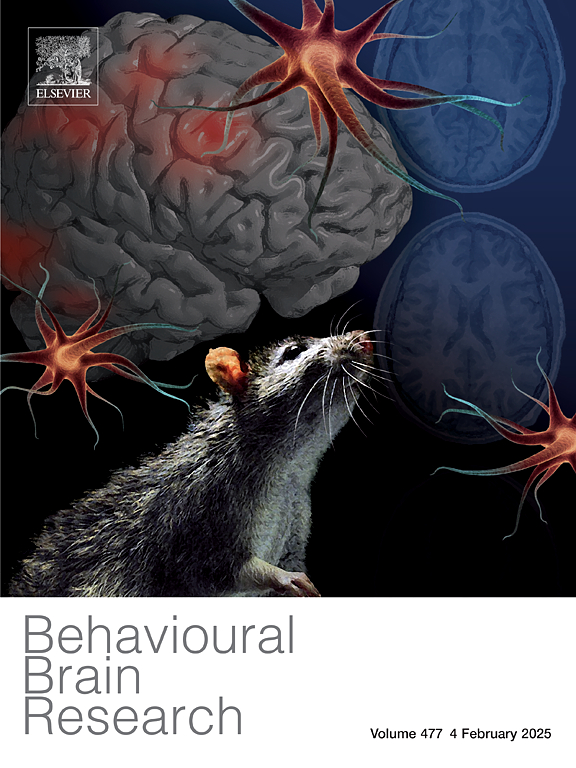胎儿酒精谱系障碍小鼠模型的认知功能受损和海马神经元树突形态改变
IF 2.3
3区 心理学
Q2 BEHAVIORAL SCIENCES
引用次数: 0
摘要
产前乙醇暴露是神经发育障碍的主要可预防原因,临床分类为胎儿酒精谱系障碍(FASD)。本研究探讨了发育性酒精暴露如何影响海马锥体神经元的树突形态,重点研究了对神经元结构和突触功能至关重要的肌动蛋白细胞骨架动力学。在此背景下,我们假设发育性酒精暴露会破坏肌动蛋白细胞骨架动力学,导致海马的认知缺陷和树突重塑。从出生后第2-8天开始,新生小鼠(C57BL/6 J)腹腔注射乙醇(5.0 g/kg),建立妊娠晚期等效酒精暴露FASD模型。在出生后28天,使用新位置识别(NLR)、新物体识别(NOR)和Morris水迷宫(MWM)评估认知表现。高尔基染色评估海马CA1区的树突形态,并使用生化分析测量聚合(f -肌动蛋白)与球状肌动蛋白(g -肌动蛋白)的比例。结果显示,两性在NOR和MWM测试中的表现下降证明,发育性酒精暴露显著损害了识别和空间记忆。高尔基染色显示雄性和雌性幼年小鼠海马锥体神经元CA1区树突树突复杂性和脊柱密度降低。生化分析进一步显示,两性海马f -肌动蛋白/ g -肌动蛋白比值下降,聚合f -肌动蛋白水平下降。这些发现强调了细胞骨架完整性在认知发育中的关键作用,并强调了FASD治疗干预的潜在目标。本文章由计算机程序翻译,如有差异,请以英文原文为准。
Impaired cognitive function and altered dendritic morphology of hippocampal neurons in a mouse model of fetal alcohol spectrum disorder
Prenatal ethanol exposure is a leading preventable cause of neurodevelopmental disability, clinically categorized under fetal alcohol spectrum disorders (FASD). This study explores how developmental alcohol exposure affects the dendritic morphology of hippocampal pyramidal neurons, focusing on the actin cytoskeleton's dynamics essential for neuronal structure and synaptic function. Within this context, we hypothesized that developmental alcohol exposure disrupts actin cytoskeleton dynamics, leading to cognitive deficits and dendritic remodeling in the hippocampus. Neonatal mice (C57BL/6 J) were administered ethanol (5.0 g/kg) intraperitoneally from postnatal day 2–8, establishing a third trimester-equivalent alcohol exposure FASD model. At postnatal day 28, cognitive performance was evaluated using novel location recognition (NLR), novel object recognition (NOR), and the Morris water maze (MWM). Golgi staining assessed dendritic morphology in the hippocampal CA1 region, and the ratio of polymerized (F-actin) to globular actin (G-actin) was measured using a biochemical assay. The results revealed that developmental alcohol exposure significantly impaired recognition and spatial memory, as evidenced by decreased performances in the NOR and MWM tests across both sexes. Golgi staining revealed reduced dendritic arborization complexity and spine density in the CA1 region of the hippocampal pyramidal neurons of both male and female juvenile mice. Biochemical analyses further revealed decresed hipocampal F-actin/G-actin ratios and decreased levels of polymerized F-actin in both sexes. These findings underscore the critical role of cytoskeletal integrity in cognitive development and highlight potential targets for therapeutic intervention in FASD.
求助全文
通过发布文献求助,成功后即可免费获取论文全文。
去求助
来源期刊

Behavioural Brain Research
医学-行为科学
CiteScore
5.60
自引率
0.00%
发文量
383
审稿时长
61 days
期刊介绍:
Behavioural Brain Research is an international, interdisciplinary journal dedicated to the publication of articles in the field of behavioural neuroscience, broadly defined. Contributions from the entire range of disciplines that comprise the neurosciences, behavioural sciences or cognitive sciences are appropriate, as long as the goal is to delineate the neural mechanisms underlying behaviour. Thus, studies may range from neurophysiological, neuroanatomical, neurochemical or neuropharmacological analysis of brain-behaviour relations, including the use of molecular genetic or behavioural genetic approaches, to studies that involve the use of brain imaging techniques, to neuroethological studies. Reports of original research, of major methodological advances, or of novel conceptual approaches are all encouraged. The journal will also consider critical reviews on selected topics.
 求助内容:
求助内容: 应助结果提醒方式:
应助结果提醒方式:


